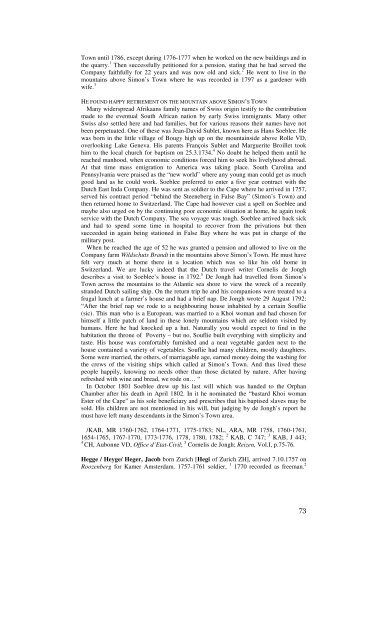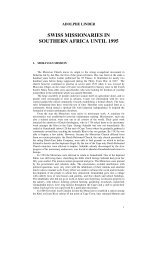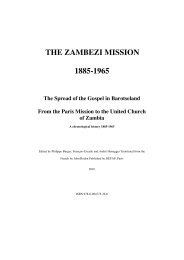THE SWISS IN SOUTHERN AFRICA 1652-1970 - swissroots-za.ch
THE SWISS IN SOUTHERN AFRICA 1652-1970 - swissroots-za.ch
THE SWISS IN SOUTHERN AFRICA 1652-1970 - swissroots-za.ch
Create successful ePaper yourself
Turn your PDF publications into a flip-book with our unique Google optimized e-Paper software.
Town until 1786, except during 1776-1777 when he worked on the new buildings and in<br />
the quarry. 1 Then successfully petitioned for a pension, stating that he had served the<br />
Company faithfully for 22 years and was now old and sick. 2 He went to live in the<br />
mountains above Simon’s Town where he was recorded in 1797 as a gardener with<br />
wife. 3<br />
HE FOUND HAPPY RETIREMENT ON <strong>THE</strong> MOUNTA<strong>IN</strong> ABOVE SIMON’S TOWN<br />
Many widerspread Afrikaans family names of Swiss origin testify to the contribution<br />
made to the eventual South African nation by early Swiss immigrants. Many other<br />
Swiss also settled here and had families, but for various reasons their names have not<br />
been perpetuated. One of these was Jean-David Sublet, known here as Hans Soeblee. He<br />
was born in the little village of Bougy high up on the mountainside above Rolle VD,<br />
overlooking Lake Geneva. His parents François Sublet and Marguerite Broillet took<br />
him to the local <strong>ch</strong>ur<strong>ch</strong> for baptism on 25.3.1734. 4 No doubt he helped them until he<br />
rea<strong>ch</strong>ed manhood, when economic conditions forced him to seek his livelyhood abroad.<br />
At that time mass emigration to America was taking place. South Carolina and<br />
Pennsylvania were praised as the “new world” where any young man could get as mu<strong>ch</strong><br />
good land as he could work. Soeblee preferred to enter a five year contract with the<br />
Dut<strong>ch</strong> East Inda Company. He was sent as soldier to the Cape where he arrived in 1757,<br />
served his contract period “behind the Steeneberg in False Bay” (Simon’s Town) and<br />
then returned home to Switzerland. The Cape had however cast a spell on Soeblee and<br />
maybe also urged on by the continuing poor economic situation at home, he again took<br />
service with the Dut<strong>ch</strong> Company. The sea voyage was tough. Soeblee arrived back sick<br />
and had to spend some time in hospital to recover from the privations but then<br />
succeeded in again being stationed in False Bay where he was put in <strong>ch</strong>arge of the<br />
military post.<br />
When he rea<strong>ch</strong>ed the age of 52 he was granted a pension and allowed to live on the<br />
Company farm Wilds<strong>ch</strong>uts Brandt in the mountains above Simon’s Town. He must have<br />
felt very mu<strong>ch</strong> at home there in a location whi<strong>ch</strong> was so like his old home in<br />
Switzerland. We are lucky indeed that the Dut<strong>ch</strong> travel writer Cornelis de Jongh<br />
describes a visit to Soeblee’s house in 1792. 5 De Jongh had travelled from Simon’s<br />
Town across the mountains to the Atlantic sea shore to view the wreck of a recently<br />
stranded Dut<strong>ch</strong> sailing ship. On the return trip he and his companions were treated to a<br />
frugal lun<strong>ch</strong> at a farmer’s house and had a brief nap. De Jongh wrote 29 August 1792:<br />
“After the brief nap we rode to a neighbouring house inhabited by a certain Souflie<br />
(sic). This man who is a European, was married to a Khoi woman and had <strong>ch</strong>osen for<br />
himself a little pat<strong>ch</strong> of land in these lonely mountains whi<strong>ch</strong> are seldom visited by<br />
humans. Here he had knocked up a hut. Naturally you would expect to find in the<br />
habitation the throne of Poverty – but no, Souflie built everything with simplicity and<br />
taste. His house was comfortably furnished and a neat vegetable garden next to the<br />
house contained a variety of vegetables. Souflie had many <strong>ch</strong>ildren, mostly daughters.<br />
Some were married, the others, of marriagable age, earned money doing the washing for<br />
the crews of the visiting ships whi<strong>ch</strong> called at Simon’s Town. And thus lived these<br />
people happily, knowing no needs other than those dictated by nature. After having<br />
refreshed with wine and bread, we rode on… “<br />
In October 1801 Soeblee drew up his last will whi<strong>ch</strong> was handed to the Orphan<br />
Chamber after his death in April 1802. In it he nominated the “bastard Khoi woman<br />
Ester of the Cape” as his sole beneficiary and prescribes that his baptised slaves may be<br />
sold. His <strong>ch</strong>ildren are not mentioned in his will, but judging by de Jongh’s report he<br />
must have left many descendants in the Simon’s Town area.<br />
/KAB, MR 1760-1762, 1764-1771, 1775-1783; NL, ARA, MR 1758, 1760-1761,<br />
1654-1765, 1767-1770, 1773-1776, 1778, 1780, 1782; 2 KAB, C 747; 3 KAB, J 443;<br />
4 CH, Aubonne VD, Office d’Etat-Civil; 5 Cornelis de Jongh; Reizen, Vol.I, p.75-76.<br />
Hegge / Heyge/ Heger, Jacob born Zuri<strong>ch</strong> [Hegi of Zuri<strong>ch</strong> ZH], arrived 7.10.1757 on<br />
Roozenberg for Kamer Amsterdam. 1757-1761 soldier, 1 1770 recorded as freeman. 2<br />
73







